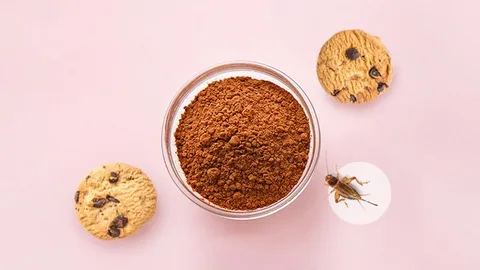In recent years, cricket flour has emerged as an innovative and sustainable protein source, garnering attention from health enthusiasts, environmentalists, and adventurous foodies alike. This comprehensive guide will explore cricket flour in depth, covering its nutritional profile, taste, and how to incorporate it into your diet through various recipes. We’ll also address frequently asked questions at the end.
What is Cricket Flour?
Cricket flour, also known as cricket powder, is made from ground crickets. It’s recognized for its high protein content, sustainability, and versatility as an ingredient. The process involves raising crickets, typically on a diet of grains and vegetables, then cleaning, roasting, and grinding them into a fine powder.
Nutritional Profile
Protein Count
Cricket flour is a complete protein source, containing all nine essential amino acids. On average, cricket flour consists of about 60-70% protein by weight, making it one of the most protein-dense foods available.
Vitamins and Minerals
Cricket flour is rich in several key vitamins and minerals, including B vitamins (especially B12), iron, zinc, magnesium, and calcium. These nutrients play vital roles in energy metabolism, immune function, bone health, and more.
Fiber
Unlike many animal protein sources, cricket flour contains a significant amount of dietary fiber. This fiber, primarily in the form of chitin (found in the cricket’s exoskeleton), is beneficial for digestive health.
Fats
The fat content in cricket flour is relatively low, with a balance of saturated and unsaturated fats, including omega-3 fatty acids, which are crucial for heart and brain health.
Taste and Texture
Cricket flour has a nutty, earthy flavor that can vary slightly depending on the cricket’s diet and the roasting process. Its fine texture makes it an excellent addition to baked goods, smoothies, and other recipes, often without a noticeable difference in taste.
Environmental Benefits
Cricket farming is notably more sustainable than traditional livestock farming. Crickets require significantly less water, land, and feed to produce the same amount of protein. They also emit fewer greenhouse gases, making cricket flour a more environmentally friendly protein choice.
How to Use Cricket Flour
Cricket flour can replace a portion of regular flour in almost any recipe, from bread and pancakes to cookies and protein bars. It’s also a great addition to smoothies for an extra protein boost. Here are some guidelines:
- Baking Substitute up to 10-20% of the flour in a recipe with cricket flour to maintain the structure and texture of the baked goods.
- Smoothies Add 1-2 tablespoons of cricket flour to your favorite smoothie recipe for a protein boost.
- Protein Bars and Balls Cricket flour can be a key ingredient in homemade protein bars or energy balls, mixed with nuts, seeds, and dried fruit.
Recipes
Here are a couple of simple recipes to get you started with cricket flour:
Cricket Flour Pancakes
Ingredients:
- 1 cup all-purpose flour
- ¼ cup cricket flour
- 2 tablespoons sugar
- 1 tablespoon baking powder
- ½ teaspoon salt
- 1 cup milk
- 2 eggs
- 2 tablespoons melted butter
- 1 teaspoon vanilla extract
Instructions:
In a large bowl, whisk together the all-purpose flour, cricket flour, sugar, baking powder, and salt
In another bowl, beat the milk, eggs, melted butter, and vanilla extract until well combined.
Pour the wet ingredients into the dry ingredients, stirring until just combined.
Heat a non-stick pan over medium heat and scoop ¼ cup of batter for each pancake.
Cook until bubbles form on the surface, then flip and cook until golden brown.
Serve with your favorite toppings.
Cricket Flour Chocolate Chip Cookies
Ingredients
- ¾ cup all-purpose flour
- ¼ cup cricket flour
- ½ teaspoon baking soda
- ¼ teaspoon salt
- ½ cup softened butter
- ½ cup brown sugar
- ¼ cup granulated sugar
- 1 teaspoon vanilla extract
- 1 large egg
- 1 cup chocolate chips
Instructions
Preheat your oven to 375°F (190°C).
In a bowl, whisk together the all-purpose flour, cricket flour, baking soda, and salt.
In another bowl, cream together the butter, brown sugar, granulated sugar, and vanilla extract until light and fluffy.
Beat in the egg until well combined.
Gradually mix in the dry ingredients until just combined, then fold in the chocolate chips.
Drop tablespoon-sized balls of dough onto a baking sheet lined with parchment paper.
Bake for 8-10 minutes, or until the edges are lightly golden.
Let cool on the baking sheet for a few minutes before transferring to a wire rack to cool completely.
FAQs
Does cricket flour taste like crickets?
While it has a distinctive nutty, earthy flavor, it doesn’t strongly taste like crickets. When mixed with other ingredients, its taste is barely noticeable.
Is cricket flour safe for everyone to eat?
People with a shellfish allergy should be cautious, as crickets are arthropods, similar to shellfish, and may trigger allergies.
How do I store cricket flour?
Keep it in an airtight container in a cool, dry place. It can also be refrigerated to extend its shelf life.
Can cricket flour be used as a complete replacement for all-purpose flour?
It’s best used as a partial replacement (up to 20%) in baking recipes to maintain the desired texture and structure of the final product.
Is cricket flour gluten-free?
Yes, cricket flour is naturally gluten-free, but if you’re gluten-sensitive, ensure it’s processed in a gluten-free facility to avoid cross-contamination.
Where can I buy cricket flour?
Cricket flour is available online, in health food stores, and in some specialty food markets.
Cricket flour is a versatile, nutritious, and sustainable alternative protein source that’s gaining popularity worldwide. Whether you’re a seasoned chef or a curious newcomer, incorporating cricket flour into your diet can be an exciting way to enhance your meals both nutritionally and environmentally.
- Upper Face Anti Wrinkle Treatment Near Redhill, Surrey - January 5, 2025
- Xela Rederm Skin Booster Treatments Near Ripley, Surrey - January 4, 2025
- Traptox Aka Trapezius Botox Treatment Near Chelsham, Surrey - January 3, 2025



